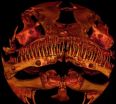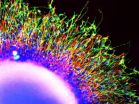(Press-News.org) With the commodification of digital cameras, digital video has become so easy to produce that human beings can have trouble keeping up with it. Among the tools that computer scientists are developing to make the profusion of video more useful are algorithms for activity recognition — or determining what the people on camera are doing when.
At the Conference on Computer Vision and Pattern Recognition in June, Hamed Pirsiavash, a postdoc at MIT, and his former thesis advisor, Deva Ramanan of the University of California at Irvine, will present a new activity-recognition algorithm that has several advantages over its predecessors.
One is that the algorithm's execution time scales linearly with the size of the video file it's searching. That means that if one file is 10 times the size of another, the new algorithm will take 10 times as long to search it — not 1,000 times as long, as some earlier algorithms would.
Another is that the algorithm is able to make good guesses about partially completed actions, so it can handle streaming video. Partway through an action, it will issue a probability that the action is of the type that it's looking for. It may revise that probability as the video continues, but it doesn't have to wait until the action is complete to assess it.
Finally, the amount of memory the algorithm requires is fixed, regardless of how many frames of video it's already reviewed. That means that, unlike many of its predecessors, it can handle video streams of any length (or files of any size).
The grammar of action
Enabling all of these advances is the appropriation of a type of algorithm used in natural language processing, the computer science discipline that seeks techniques for interpreting sentences written in natural language.
"One of the challenging problems they try to solve is, if you have a sentence, you want to basically parse the sentence, saying what is the subject, what is the verb, what is the adverb," Pirsiavash says. "We see an analogy here, which is, if you have a complex action — like making tea or making coffee — that has some subactions, we can basically stitch together these subactions and look at each one as something like verb, adjective, and adverb."
On that analogy, the rules defining relationships between subactions are like rules of grammar. When you make tea, for instance, it doesn't matter whether you first put the teabag in the cup or put the kettle on the stove. But it's essential that you put the kettle on the stove before pouring the water into the cup. Similarly, in a given language, it could be the case that nouns can either precede or follow verbs, but that adjectives must always precede nouns.
For any given action, Pirsiavash and Ramanan's algorithm must thus learn a new "grammar." And the mechanism that it uses is the one that many natural-language-processing systems rely on: machine learning. Pirsiavash and Ramanan feed their algorithm training examples of videos depicting a particular action, and specify the number of subactions that the algorithm should look for. But they don't give it any information about what those subactions are, or what the transitions between them look like.
Pruning possibilities
The rules relating subactions are the key to the algorithm's efficiency. As a video plays, the algorithm constructs a set of hypotheses about which subactions are being depicted where, and it ranks them according to probability. It can't limit itself to a single hypothesis, as each new frame could require it to revise its probabilities. But it can eliminate hypotheses that don't conform to its grammatical rules, which dramatically limits the number of possibilities it has to canvass.
The researchers tested their algorithm on eight different types of athletic endeavor — such as weightlifting and bowling — with training videos culled from YouTube. They found that, according to metrics standard in the field of computer vision, their algorithm identified new instances of the same activities more accurately than its predecessors.
Pirsiavash is particularly interested in possible medical applications of action detection. The proper execution of physical-therapy exercises, for instance, could have a grammar that's distinct from improper execution; similarly, the return of motor function in patients with neurological damage could be identified by its unique grammar. Action-detection algorithms could also help determine whether, for instance, elderly patients remembered to take their medication — and issue alerts if they didn't.
INFORMATION:
Algorithm enables computers to identify actions much more efficiently
Techniques from natural-language processing enable computers to efficiently search video for actions
2014-05-13
ELSE PRESS RELEASES FROM THIS DATE:
Mayo Clinic study identifies strategies that reduce early hospital readmissions
2014-05-13
ROCHESTER, Minn. — May 13, 2014 — A Mayo Clinic review of 47 studies found that 30-day readmissions can be reduced by almost 20 percent when specific efforts are taken to prevent them. Key among these are interventions to help patients deal with the work passed on to them at discharge. The results of the review are published in this week's issue of JAMA Internal Medicine.
"Reducing early hospital readmissions is a policy priority aimed at improving quality of care and lowering costs," says Aaron Leppin, M.D., a research associate in Mayo Clinic's Knowledge and Evaluation ...
Novel protein fragments may protect against Alzheimer's
2014-05-13
The devastating loss of memory and consciousness in Alzheimer's disease is caused by plaque accumulations and tangles in neurons, which kill brain cells. Alzheimer's research has centered on trying to understand the pathology as well as the potential protective or regenerative properties of brain cells as an avenue for treating the widespread disease.
Now Prof. Illana Gozes, the incumbent of the Lily and Avraham Gildor Chair for the Investigation of Growth Factors and director of the Adams Super Center for Brain Studies at the Sackler Faculty of Medicine and a member ...
A tiny, toothy catfish with bulldog snout defies classification
2014-05-13
PHILADELPHIA (May 13, 2014)— Kryptoglanis shajii is a strange fish – and the closer scientists look, the stranger it gets. This small subterranean catfish sees the light of day and human observers only rarely, when it turns up in springs, wells and flooded rice paddies in the Western Ghats mountain region of Kerala, India. It was first described as a new species in 2011.
Soon after that, John Lundberg, PhD, one of the world's leading authorities on catfishes, started taking a closer look at several specimens.
"The more we looked at the skeleton, the stranger it got," ...
UTMB study discovers cause of many preterm births
2014-05-13
A new study by researchers at the University of Texas Medical Branch at Galveston is the first to show that premature aging of the placenta due to oxidative stress is the cause of many preterm births. The study appears today in the American Journal of Pathology.
Researchers took fetal membranes, exposed them to oxidative stress in a lab setting (specifically cigarette smoke extract) and examined whether it caused rapid aging of the placental tissue. It did.
Oxidative stress factors include environmental toxins and pollution and are an inevitable component of normal ...
TB lung infection causes changes in the diversity of gut bacteria in mice
2014-05-13
Johns Hopkins researchers have found evidence in mice that a tuberculosis (TB) infection in the lungs triggers immune system signaling to the gut that temporarily decreases the diversity of bacteria in that part of the digestive tract.
The Johns Hopkins researchers showed that this decrease in diversity of gut bacteria as measured in fecal samples happened quickly — within six days after mice were exposed to an aerosol mixture of M. tuberculosis, the TB bacteria. This prompt shift in diversity, they say, suggests that the immune system is attacking the gut bacteria, decreasing ...
Get it over with: People choose more difficult tasks to get jobs done more quickly
2014-05-13
Putting off tasks until later, or procrastination, is a common phenomenon – but new research suggests that "pre-crastination," hurrying to complete a task as soon as possible, may also be common.
The research, published in Psychological Science, a journal of the Association for Psychological Science, suggests that people often opt to begin a task as soon as possible just to get it off their plate, even if they have to expend more physical effort to do so.
"Most of us feel stressed about all the things we need to do – we have to-do lists, not just on slips of paper ...
Coral reefs are critical for risk reduction & adaptation
2014-05-13
ARLINGTON, Va — Stronger storms, rising seas, and flooding are placing hundreds of millions people at risk around the world, and big part of the solution to decrease those risks is just off shore. A new study finds that coral reefs reduce the wave energy that would otherwise impact coastlines by 97 percent.
"Coral reefs serve as an effective first line of defense to incoming waves, storms and rising seas," said Dr. Michael Beck, lead marine scientist of The Nature Conservancy and a co-author of the study, "200 million people across more than 80 nations are at risk if ...
New stem cell research points to early indicators of schizophrenia
2014-05-13
LA JOLLA—Using new stem cell technology, scientists at the Salk Institute have shown that neurons generated from the skin cells of people with schizophrenia behave strangely in early developmental stages, providing a hint as to ways to detect and potentially treat the disease early.
The findings of the study, published online in April's Molecular Psychiatry, support the theory that the neurological dysfunction that eventually causes schizophrenia may begin in the brains of babies still in the womb.
"This study aims to investigate the earliest detectable changes in the ...
Preschool teacher depression linked to behavioral problems in children
2014-05-13
COLUMBUS, Ohio – Depression in preschool teachers is associated with behavioral problems ranging from aggression to sadness in children under the teachers' care, new research suggests.
The study identified one contributing factor to this link: a poor-quality atmosphere in the child care setting that exists as a result of the teacher's depressive symptoms. In this study, "teacher" refers to both classroom instructors and in-home child care providers.
Researchers conducted the study using data from a large national study that collected family information primarily from ...
Odd planet, so far from its star...
2014-05-13
This news release is available in French.
A gas giant has been added to the short list of exoplanets discovered through direct imaging. It is located around GU Psc, a star three times less massive than the Sun and located in the constellation Pisces. The international research team, led by Marie-Ève Naud, a PhD student in the Department of Physics at the Université de Montréal, was able to find this planet by combining observations from the the Gemini Observatories, the Observatoire Mont-Mégantic (OMM), the Canada-France-Hawaii Telescope (CFHT) and the W.M. Keck Observatory.
A ...
LAST 30 PRESS RELEASES:
Heart-brain connection: international study reveals the role of the vagus nerve in keeping the heart young
Researchers identify Rb1 as a predictive biomarker for a new therapeutic strategy in some breast cancers
Survey reveals ethical gaps slowing AI adoption in pediatric surgery
Stimulant ADHD medications work differently than thought
AI overestimates how smart people are, according to HSE economists
HSE researchers create genome-wide map of quadruplexes
Scientists boost cell "powerhouses" to burn more calories
Automatic label checking: The missing step in making reliable medical AI
Low daily alcohol intake linked to 50% heightened mouth cancer risk in India
American Meteorological Society announces Rick Spinrad as 2026 President-Elect
Biomass-based carbon capture spotlighted in newly released global climate webinar recording
Illuminating invisible nano pollutants: advanced bioimaging tracks the full journey of emerging nanoscale contaminants in living systems
How does age affect recovery from spinal cord injury?
Novel AI tool offers prognosis for patients with head and neck cancer
Fathers’ microplastic exposure tied to their children’s metabolic problems
Research validates laboratory model for studying high-grade serous ovarian cancer
SIR 2026 delivers transformative breakthroughs in minimally invasive medicine to improve patient care
Stem Cell Reports most downloaded papers of 2025 highlight the breadth and impact of stem cell research
Oxford-led study estimates NHS spends around 3% of its primary and secondary care budget on the health impacts of heat and cold in England
A researcher’s long quest leads to a smart composite breakthrough
Urban wild bees act as “microbial sensors” of city health.
New study finds where you live affects recovery after a hip fracture
Forecasting the impact of fully automated vehicle adoption on US road traffic injuries
Alcohol-related hospitalizations from 2016 to 2022
Semaglutide and hospitalizations in patients with obesity and established cardiovascular disease
Researchers ‘listen in’ to embryo-mother interactions during implantation using a culture system replicating the womb lining
How changing your diet could help save the world
How to make AI truly scalable and reliable for real-time traffic assignment?
Beyond fragmented markets: A new framework for efficient and stable ride-pooling
Can shape priors make road perception more reliable for autonomous driving?
[Press-News.org] Algorithm enables computers to identify actions much more efficientlyTechniques from natural-language processing enable computers to efficiently search video for actions


